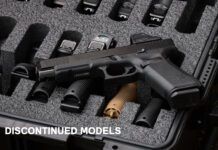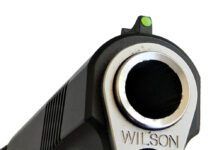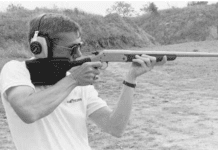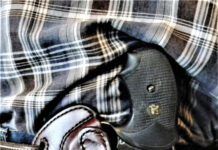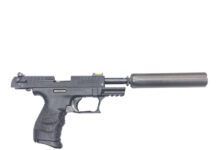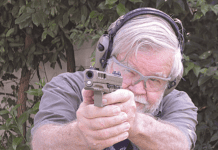Re “308 Semi-Auto Rifles: FNH-USA, Springfield, Fulton, and DSA,” May 2009 In reference to the April and May issues testing a total of six 308 semiauto rifles, I think it is important to point out the type of magazines these rifles are using. I assume the DSA FAL is using FAL mags (similar to the not tested, but excellent 308 Rock River LAR-8), and obviously the M1A is using M-14 mags. The others, I believe, are all using proprietary mags which can be elusive, untested, unreliable, and expensive. —C. L. Wilson Re “22 Magnums: Marlin’s 983S Bolt Gun Is a Magnum Bargain,” July 2009 I noticed that in this month’s issue, the chronograph data was omitted from the accuracy/chrono data in this article. Is this data available, as I would like to see it. Perhaps it will be included in a future issue as an addendum, etc.? —Jason Tam Unless there’s something odd, we usually don’t include the velocity and energy data on small-diameter and rimfire cartridges, just the accuracy data. —Todd Woodard Underscoring a Dislike for Underscore I just want to say how much I dislike the idea of the underscored text in the “Our Team Said:” portion of your reviews. What’s the matter with just setting it in italic like in Firing Line. Or use a different typeface? Or put a red 2-point rule around it, or put it over a light screen. Anything but underscore! 🙁 Yuk! —Greg Fischer I agree. I removed the underscore effective with the August 09 issue. The “Our Team Said” summaries will be in boldface type, no underscore, no color. Basic black. —tw So Many 45s After receiving several issues of Gun Tests, I am very happy with the articles. The tests are very thorough, and as a lefty I like that you usually include info on how the gun functioned for left-handed people. However I am somewhat disappointed with what guns are chosen for tests, particularly among semi-auto pistols. It seems that there is always at least one evaluation for 45s in every issue. I would have thought that 40-cal and 9mm reviews would be more prevalent. I have to wonder, are so many 45 cals tested because that’s what the readers want, or because the staff is infatuated with 45s. —Scott McMinn We do move the calibers around, but the overwhelming number of responses are for 22s and 45s, followed by 9mms. We probably test more 45s because so much of the handgun aftermarket development is for the 1911 platform. However, without naming names, I’m aware of only one staffer who carries or even prefers a 45 for daily use. The other carry guns I know about include an S&W 32 H&R Magnum, a SIG Sauer 357 SIG, two 9mms, and a Ruger LCP 380. But we do tend to change around as we test. —tw Subject: 6.5×55 bullets (.264) I own a Remington Classic 700 in 6.5×55. I want to load the best bullet that I can for the gun. I hunt mostly whitetails, but I would like to set up and load a bullet for this gun that would be right for elk. Federal used to sell a loaded round using the Trophy Bonded Bear Claw, but it is not available any longer. Is that bullet available for purchase? If not, what bullet would you recommend that is available in this caliber? —Sam Allen Though I couldn’t find a Trophy Bonded load, Cheaper Than Dirt has two selections that might fit your needs for elk. The RWS 6.5×55 DK 140-grain load uses a twin-core projectile consisting of two lead cores of different hardness (a softer tip core backed by a harder tail core) surrounded by a jacket of tombac (an alloy of copper and zinc). The 140-grain bullet runs at 2,855 fps and generates 2,534 ft.-lbs. of energy at the muzzle. At 300 yards, the 140-grain projectile travels at 2,016 fps and produces 1,263 ft.-lbs. of energy. Also at CTD is a Norma 156-grain load with the company’s Oryx bullet, a bonded design. Its muzzle velocity is 2600 fps, which produces 2342 ft.-lbs. of energy. At 300 yards, those numbers are 1887 fps and 1234 ft.-lbs. Rather than the 6.5, however, I’d rather you jump up to at least a 280 for elk, maybe more.—tw Re “Guncrafter Industries 50 GI Kit: Great Conversion for Glock 21,” July 2009 Two things I feel I must correct on your comments on the Glock Model 21 used for the conversion base. Glocks, as a rule, do not have slide releases. They have slide stops. With the 17L and 24 competition models, a different part was introduced that could be used like a slide release, but the base models continue to have slide stops. I am surprised you were able to take apart the Glock so easily since you did it incorrectly. You will find the sliding plate moves a lot easier if you pull the trigger first. In fact, I was surprised you continued to take it apart that way. I did it that way once on my Model 20, and it was so difficult to pull down that plate I read the instructions again and realized my mistake. —Bob J. Taylor A slide release, not stop, is what we call it—no matter how Glock designates it—because in a speed reload after the gun has been inadvertently run dry and has its slide locked back, the fastest way to get it reloaded is to insert a fresh magazine and hit that lever with your left thumb as you remake your grip, releasing the slide to run forward. Any training school worth its salt will teach this technique. The Glock lever is too small and slippery to make that easy. As to takedown, what I wrote works easily and perfectly. Of course, it also works if the gun is first uncocked. It makes absolutely no difference in the force needed to pull down the takedown slide whether the gun is cocked or uncocked, if you first pull slightly rearward on the slide and hold it there, as I wrote. And it is easier to pull and hold the slide slightly rearward if the gun is cocked, exactly as I wrote it. —Ray Ordorica I read with interest your review of the 50 G.I. kit in the July 2009 issue. I’m a little disappointed that you didn’t test with the 21SF, or at least comment on how it might have been different with that frame. I don’t know why it’s not on the Glock website, but that’s a pretty lame excuse for not using it, especially since you’ve reviewed the gun in previous issues. I’m small handed, and the SF makes a big difference to me. As a new subscriber, I didn’t have the benefit of the prior reviews. Thanks for listening. —Larry Snetman We didn’t test with the 21SF for two reasons. First, Glock doesn’t list on its website, so most people are unaware of the existence of SF guns. Second, we had the devil of a time getting any Glock, let alone the Model 20 we used, largely because of the recent rush by everyone to buy all sorts of handguns. Glock assured us the SF guns are still available in a variety of configurations, and of course it would be a better gun platform for those with normal-to-small hands. Glock did not say why the gun is not shown on the website. There would be no penalty, we believe, in mounting the 50 GI onto that slimmer frame. Recoil is not a problem. But you still might have to have a trigger job done. —Ray Ordorica We Appreciate Good Ideas Todd, I have been a subscriber now for at least four years, and I love your magazine. There is nothing else like it in the shooting world. I wanted to offer some suggestions for future articles. Now that the AR craze is dying down, how about a story on Piston ARs. Maybe a LWRC (about $2000), Ruger (about $1500), CMMG (about $1000), and an Adams Arms conversion thrown in for good measure ($350). I’d also like to see you cover competition-specific guns, maybe USPSA Production Class/IDPA SSP—Glock 34, MP Pro, SIG Sauer 226 USPSA model. Also, it has been a while, but I’d like to see some reviews of shooting instruction, maybe Magpul Dynamics, or Pat Rogers, or something like that. —Elliott Peterson Gene Taylor is working on a comparison of piston-driven 223s (not all are ARs) right now. I hope to include that story in the October issue. And we agree that a price stratification is necessary to kick off this category. That comparison will include the SIG Sauer 556 SWAT 556032, $2399; the Ruger SR556, $1995; and the Kel-Tec SU16C, $775. And we’ve already discussed a piston-conversion-kit story down the road. Roger Eckstine shoots a lot of USPSA, so I’ve forwarded your lineup to him for future action. I don’t see doing a lot of shooting instruction stories down the road, however. We test as teams, so that would make a service evaluation difficult. —tw Re “Two Affordable 1911s: Rock Island Armory Beats Firestorm,” July 2009 I enjoyed the article on affordable 1911s, and it’s nice to read about inexpensive models performing well in a market saturated with very pricey examples. I was curious if there were a lot of MIM parts used in each of these two models. I’m assuming there are, but would still be interested to know if that’s where most of the cost savings were found, or could it have been the fact they are manufactured in the Philippines? —David Sonnier Glad you enjoyed the report! The cost saving is a result primarily of cast frames and cast slides. There is MIM (Metal Injection Molding) in either. You may pick out MIM by looking under magnification, and you will see rough surface areas. The first RIA pistols appeared, for the life of me, to have GI surplus parts—but they worked just fine. MIM, cast slides, new machinery, and modest operating costs are what makes the RIA and Firestorm pistols affordable. —Bob Campbell A comment on the Rock Island 1911. Amazing pistol for the price. Makes me wonder why I spent so much on my 1911. One word of warning, however. Rock Island uses softer steel in its frames and slides, and if you are one of those guys who shoots thousands of rounds a year, you might want to stay away from the Rock Island. For the rest of us, what a bargain! —R. Fincher Re “Affordable 45s: Para USA, CZ, and Beretta Shoot It Out,” June 2009 On page 12 of the June 2009 issue you review the PARA USA GI Expert and grade it an A- in the module with the specifications. On the next page, your report card summary grades it B+. Can you explain this? I just subscribed, so maybe I’m missing something. —Tony Del Vecchio Sadly, Tony, you’re not missing anything at all. I didn’t update the template I use for the Report Card Summary. The Para’s correct grade was in the module, an A-. I regret the error. —tw Subject: Ruger SR556 I hope you have the chance to test the new Ruger in the near future. There has to be a good bit of buzz about an AR-15–based Ruger, given that company’s pride in being a gunmaker “for responsible citizens.” A black rifle seems unusual from the company, just as producing 30-round magazines for the Mini-14 seemed out of character. At any rate, I’ll bet I’m not the only one who would like to hear how well Ruger did in its version of the AR. —Jim Varner Me, too. We have one SR556 being tested already, and I have a second unit sitting on the prep table next to my desk right now. First chance I get, I’m taking the 556 and a new Stag I have to see how they do. —tw Why Is Ammo in Short Supply? I have been a subscriber for over 10 years and have come to realize that when I want the straight scoop (no bull or guesswork), your magazine and staff are the ones to go to. Can you advise what is the cause for the handgun ammo shortage, and also why 380s are not at all available? —Lawrence Jon Barden In a word, fear has propelled the recent buying surge, in my opinion. Most gun owners anticipate restrictive gun laws coming soon, and they’ve been buying while the buying is good—or possible. I also hear that gun-safe sales are up—but the scuttlebutt is they’re being used to store money, not guns. As for the 380 shortage, that round has long been a below-the-radar favorite. Supplies do seem to have loosened recently, so perhaps the surge will tail off now. We’ll see. —tw


